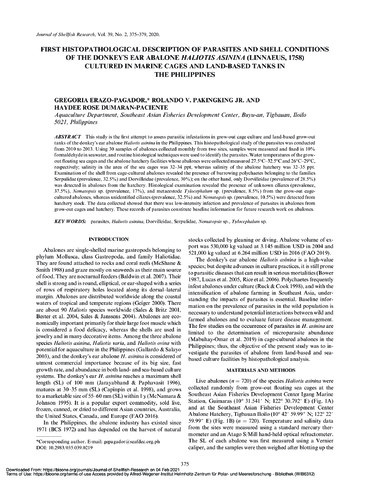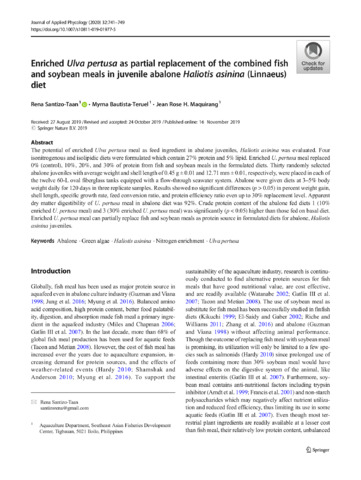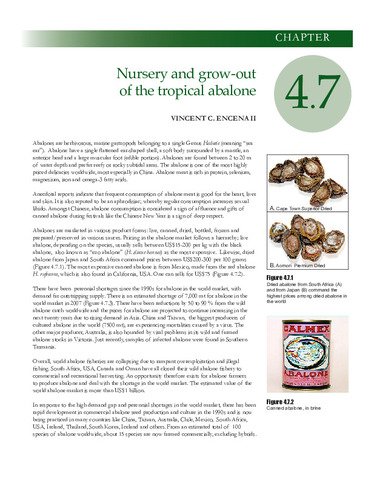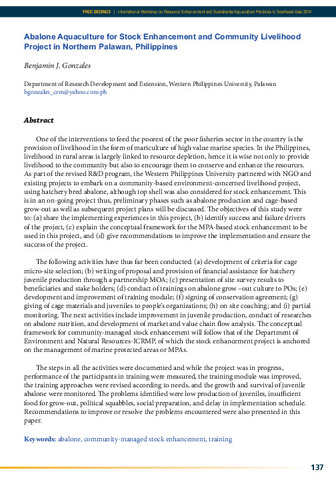First histopathological description of parasites and shell conditions of the donkey's ear abalone Haliotis asinina (Linnaeus, 1758) cultured in marine cages and land-based tanks in the Philippines
- Global styles
- MLA
- Vancouver
- Elsevier - Harvard
- APA
- Help

View/Open
Date
2020-08-26Page views
2,084ASFA keyword
AGROVOC keyword
Taxonomic term
Metadata
Show full item recordCited times in Scopus
- Citations
- Scopus - Citation Indexes: 2
- Captures
- Mendeley - Readers: 5
Share
Abstract
This study is the first attempt to assess parasitic infestations in grow-out cage culture and land-based grow-out tanks of the donkey's ear abalone Haliotis asinina in the Philippines. This histopathological study of the parasites was conducted from 2010 to 2013. Using 30 samples of abalones collected monthly from two sites, samples were measured and fixed in 10% formaldehyde in seawater, and routine histological techniques were used to identify the parasites. Water temperatures of the grow-out floating sea cages and the abalone hatchery facilities whose abalones were collected measured 27.5°C–32.5°C and 26°C–29°C, respectively; salinity in the area of the sea cages was 32–34 ppt, whereas salinity of the abalone hatchery was 32–35 ppt. Examination of the shell from cage-cultured abalones revealed the presence of burrowing polychaetes belonging to the families Serpulidae (prevalence, 32.5%) and Dorvilleidae (prevalence, 30%); on the other hand, only Dorvilleidae (prevalence of 28.5%) was detected in abalones from the hatchery. Histological examination revealed the presence of unknown ciliates (prevalence, 37.5%), Nematopsis sp. (prevalence, 17%), and metacestode Tylocephalum sp. (prevalence, 8.5%) from the grow-out cage-cultured abalones, whereas unidentified ciliates (prevalence, 32.5%) and Nematopsis sp. (prevalence, 10.5%) were detected from hatchery stock. The data collected showed that there was low-intensity infection and prevalence of parasites in abalones from grow-out cages and hatchery. These records of parasites constitute baseline information for future research work on abalones.
Suggested Citation
Erazo-Pagador, G., Pakingking, R. V., Jr., & Dumaran-Paciente, H. R. (2020). First histopathological description of parasites and shell conditions of the donkey's ear abalone Haliotis asinina (Linnaeus, 1758) cultured in marine cages and land-based tanks in the Philippines. Journal of Shellfish Research , 39(2), 375-379. https://doi.org/10.2983/035.039.0219
Type
ArticleISSN
0730-8000Collections
- Journal Articles [1249]
Related items
Showing items related by title, author, creator and subject.
-
Enriched Ulva pertusa as partial replacement of the combined fish and soybean meals in juvenile abalone Haliotis asinina (Linnaeus) diet
Santizo-Taan, Rena; Bautista-Teruel, Myrna; Maquirang, Jean Rose H. (Springer Verlag, 2020)The potential of enriched Ulva pertusa meal as feed ingredient in abalone juveniles, Haliotis asinina was evaluated. Four isonitrogenous and isolipidic diets were formulated which contain 27% protein and 5% lipid. Enriched ...
-
Nursery and grow-out of the tropical abalone
Encena III, Vincent C. (Aquaculture Department, Southeast Asian Fisheries Development Center, 2009) -
Abalone aquaculture for stock enhancement and community livelihood project in northern Palawan, Philippines
Gonzales, Benjamin J. (Aquaculture Department, Southeast Asian Fisheries Development Center, 2015)One of the interventions to feed the poorest of the poor fisheries sector in the country is the provision of livelihood in the form of mariculture of high value marine species. In the Philippines, livelihood in rural areas ...







